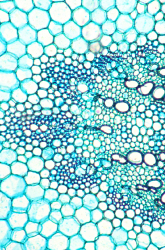Descripción

I cut a beet into identical weight sections (14 g), and placed then in jars with varying salt concentrations: 0%, 10%, 20%, 30%, 40%, and 50%. I set up 3 sets of these, and placed 1 set in a freezer, 1 set in the refrigerator, and the final set at room temperature. After 24 hours I measured cell damage by measuring the concentration of beet pigment in the water; the rupturing of cells would release the pigment into the water. I used a spectrophotometer to measure the percent transmission of light as a measure of pigment concentration in the water.There was little cell damage in the refrigerator and none in the room temperature jars, but the freezing caused considerable cell damage. However, when cells were preserved with a salt concentration greater than 20%, there was considerably less damage, and little cell damage at a concentration of 40%.The significance of these findings is that there is a way to save cells and preserve them. This also indicates that someday, people may be able to freeze animals or humans and bring them back to life.
It is an educational content by education.com.
By clicking on the title of this resource, you will be redirected to the content. If you want to download the project, you just have to join the website, which now is for FREE.
Autores
Autor Stephanie, grade 8
Categorias Ficha para imprimir, Experimento/Práctica, 12-14 años, Science Fair - Education, Biología, Inglés add
Tag
Data de publicação 27 / 08 / 2020
Licença Respeita a licença original do recurso.
Deseja fazer um comentário? Iniciar sessão





Comentários
mode_comment0